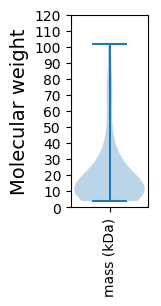
Arthrobacter phage YesChef
Taxonomy: Viruses; Duplodnaviria; Heunggongvirae; Uroviricota; Caudoviricetes; Caudovirales; Siphoviridae; Yangvirus; unclassified Yangvirus
Average proteome isoelectric point is 6.37
Get precalculated fractions of proteins

Virtual 2D-PAGE plot for 69 proteins (isoelectric point calculated using IPC2_protein)
Get csv file with sequences according to given criteria:
* You can choose from 21 different methods for calculating isoelectric point
Summary statistics related to proteome-wise predictions



Protein with the lowest isoelectric point:
>tr|A0A6G8R2V6|A0A6G8R2V6_9CAUD Uncharacterized protein OS=Arthrobacter phage YesChef OX=2713261 GN=31 PE=4 SV=1
MM1 pKa = 7.84LEE3 pKa = 4.3YY4 pKa = 10.84LDD6 pKa = 5.91DD7 pKa = 5.77DD8 pKa = 5.26PDD10 pKa = 5.47LEE12 pKa = 5.09LDD14 pKa = 3.26PRR16 pKa = 11.84EE17 pKa = 4.38YY18 pKa = 11.11VCEE21 pKa = 4.2TCRR24 pKa = 11.84LTHH27 pKa = 6.06WRR29 pKa = 11.84GAPDD33 pKa = 3.65PCDD36 pKa = 3.41RR37 pKa = 11.84SS38 pKa = 3.51
MM1 pKa = 7.84LEE3 pKa = 4.3YY4 pKa = 10.84LDD6 pKa = 5.91DD7 pKa = 5.77DD8 pKa = 5.26PDD10 pKa = 5.47LEE12 pKa = 5.09LDD14 pKa = 3.26PRR16 pKa = 11.84EE17 pKa = 4.38YY18 pKa = 11.11VCEE21 pKa = 4.2TCRR24 pKa = 11.84LTHH27 pKa = 6.06WRR29 pKa = 11.84GAPDD33 pKa = 3.65PCDD36 pKa = 3.41RR37 pKa = 11.84SS38 pKa = 3.51
Molecular weight: 4.53 kDa
Isoelectric point according different methods:
Protein with the highest isoelectric point:
>tr|A0A6G8R305|A0A6G8R305_9CAUD Uncharacterized protein OS=Arthrobacter phage YesChef OX=2713261 GN=65 PE=4 SV=1
MM1 pKa = 7.51PRR3 pKa = 11.84KK4 pKa = 8.7KK5 pKa = 9.21TKK7 pKa = 10.15TNLPADD13 pKa = 3.55WHH15 pKa = 6.02EE16 pKa = 4.52HH17 pKa = 6.55DD18 pKa = 4.07SAEE21 pKa = 4.27ANGRR25 pKa = 11.84HH26 pKa = 4.91ITAGTEE32 pKa = 3.6VSIRR36 pKa = 11.84GEE38 pKa = 3.62RR39 pKa = 11.84GRR41 pKa = 11.84FRR43 pKa = 11.84FLKK46 pKa = 10.33RR47 pKa = 11.84VTRR50 pKa = 11.84DD51 pKa = 3.74DD52 pKa = 3.36GRR54 pKa = 11.84EE55 pKa = 3.79WLDD58 pKa = 3.17FWGGPKK64 pKa = 10.27GSEE67 pKa = 3.47AWRR70 pKa = 11.84SFSADD75 pKa = 3.0QIRR78 pKa = 11.84RR79 pKa = 11.84VHH81 pKa = 7.36RR82 pKa = 11.84INTTEE87 pKa = 3.86RR88 pKa = 11.84ALAAQHH94 pKa = 6.09KK95 pKa = 9.21AKK97 pKa = 10.74KK98 pKa = 9.0EE99 pKa = 3.87ALRR102 pKa = 11.84NAA104 pKa = 3.94
MM1 pKa = 7.51PRR3 pKa = 11.84KK4 pKa = 8.7KK5 pKa = 9.21TKK7 pKa = 10.15TNLPADD13 pKa = 3.55WHH15 pKa = 6.02EE16 pKa = 4.52HH17 pKa = 6.55DD18 pKa = 4.07SAEE21 pKa = 4.27ANGRR25 pKa = 11.84HH26 pKa = 4.91ITAGTEE32 pKa = 3.6VSIRR36 pKa = 11.84GEE38 pKa = 3.62RR39 pKa = 11.84GRR41 pKa = 11.84FRR43 pKa = 11.84FLKK46 pKa = 10.33RR47 pKa = 11.84VTRR50 pKa = 11.84DD51 pKa = 3.74DD52 pKa = 3.36GRR54 pKa = 11.84EE55 pKa = 3.79WLDD58 pKa = 3.17FWGGPKK64 pKa = 10.27GSEE67 pKa = 3.47AWRR70 pKa = 11.84SFSADD75 pKa = 3.0QIRR78 pKa = 11.84RR79 pKa = 11.84VHH81 pKa = 7.36RR82 pKa = 11.84INTTEE87 pKa = 3.86RR88 pKa = 11.84ALAAQHH94 pKa = 6.09KK95 pKa = 9.21AKK97 pKa = 10.74KK98 pKa = 9.0EE99 pKa = 3.87ALRR102 pKa = 11.84NAA104 pKa = 3.94
Molecular weight: 12.03 kDa
Isoelectric point according different methods:
Peptides (in silico digests for buttom-up proteomics)
Below you can find in silico digests of the whole proteome with Trypsin, Chymotrypsin, Trypsin+LysC, LysN, ArgC proteases suitable for different mass spec machines.| Try ESI |
 |
|---|
| ChTry ESI |
 |
|---|
| ArgC ESI |
 |
|---|
| LysN ESI |
 |
|---|
| TryLysC ESI |
 |
|---|
| Try MALDI |
 |
|---|
| ChTry MALDI |
 |
|---|
| ArgC MALDI |
 |
|---|
| LysN MALDI |
 |
|---|
| TryLysC MALDI |
 |
|---|
| Try LTQ |
 |
|---|
| ChTry LTQ |
 |
|---|
| ArgC LTQ |
 |
|---|
| LysN LTQ |
 |
|---|
| TryLysC LTQ |
 |
|---|
| Try MSlow |
 |
|---|
| ChTry MSlow |
 |
|---|
| ArgC MSlow |
 |
|---|
| LysN MSlow |
 |
|---|
| TryLysC MSlow |
 |
|---|
| Try MShigh |
 |
|---|
| ChTry MShigh |
 |
|---|
| ArgC MShigh |
 |
|---|
| LysN MShigh |
 |
|---|
| TryLysC MShigh |
 |
|---|
General Statistics
Number of major isoforms |
Number of additional isoforms |
Number of all proteins |
Number of amino acids |
Min. Seq. Length |
Max. Seq. Length |
Avg. Seq. Length |
Avg. Mol. Weight |
|---|---|---|---|---|---|---|---|
0 |
13389 |
36 |
990 |
194.0 |
21.08 |
Amino acid frequency
Ala |
Cys |
Asp |
Glu |
Phe |
Gly |
His |
Ile |
Lys |
Leu |
|---|---|---|---|---|---|---|---|---|---|
13.578 ± 0.561 | 0.478 ± 0.093 |
6.475 ± 0.378 | 6.55 ± 0.409 |
3.077 ± 0.193 | 8.201 ± 0.487 |
1.875 ± 0.142 | 4.347 ± 0.323 |
4.25 ± 0.322 | 8.522 ± 0.337 |
Met |
Asn |
Gln |
Pro |
Arg |
Ser |
Thr |
Val |
Trp |
Tyr |
|---|---|---|---|---|---|---|---|---|---|
1.875 ± 0.136 | 2.293 ± 0.241 |
5.139 ± 0.321 | 2.539 ± 0.231 |
7.342 ± 0.622 | 5.407 ± 0.278 |
6.573 ± 0.354 | 7.11 ± 0.262 |
1.748 ± 0.121 | 2.622 ± 0.195 |
Most of the basic statistics you can see at this page can be downloaded from this CSV file
Proteome-pI is available under Creative Commons Attribution-NoDerivs license, for more details see here
| Reference: Kozlowski LP. Proteome-pI 2.0: Proteome Isoelectric Point Database Update. Nucleic Acids Res. 2021, doi: 10.1093/nar/gkab944 | Contact: Lukasz P. Kozlowski |
